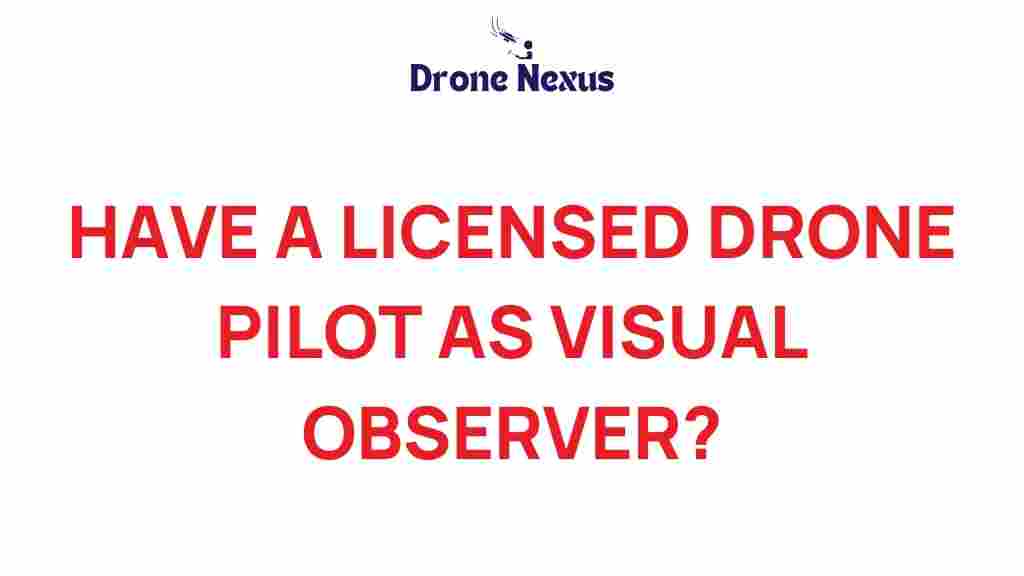Why Every Drone Operation Needs a Licensed Pilot as Visual Observer for Drone Safety
In recent years, the popularity of drones has skyrocketed, leading to their use in various industries, from photography to agriculture. However, with their increased use comes the critical responsibility of ensuring drone safety. One essential aspect of ensuring safe drone operations is employing a licensed pilot as a visual observer. In this article, we will explore the importance of having a licensed pilot present during drone operations, the roles they play, and how this practice enhances overall safety.
The Importance of Drone Safety
Drone safety is paramount in preventing accidents, injuries, and damage to property. As drones are flown in shared airspace with manned aircraft, maintaining safety is crucial. Here are some reasons why drone safety should be a top priority:
- Preventing Collisions: Drones can easily collide with other aircraft if not monitored properly.
- Protecting People and Property: Uncontrolled drones can cause harm to people on the ground or damage property.
- Compliance with Regulations: Various aviation authorities require licensed operators to ensure safe drone use.
The Role of a Licensed Pilot as a Visual Observer
A licensed pilot serves as a visual observer to enhance drone safety during operations. Their responsibilities include:
- Monitoring Airspace: Keeping an eye on the surrounding airspace for potential hazards.
- Assisting in Navigation: Providing the drone pilot with guidance on the drone’s position relative to obstacles.
- Communicating with the Pilot: Using verbal cues to alert the pilot to any issues that may arise.
Step-by-Step Process of Effective Drone Operation with a Visual Observer
To ensure safe drone operations, follow this step-by-step process that emphasizes the role of a licensed pilot as a visual observer.
Step 1: Pre-Flight Planning
Before any drone operation, thorough pre-flight planning is essential. This includes:
- Identifying the Flight Area: Choose a location that is safe and clear of obstacles.
- Checking Weather Conditions: Ensure that weather conditions are suitable for flying.
- Confirming Regulatory Compliance: Ensure all necessary permits and licenses are in place.
Step 2: Briefing the Team
Once planning is complete, conduct a briefing with the entire team, including the licensed pilot and visual observer. Discuss the following:
- Flight Objectives: Clearly outline the goals of the drone operation.
- Safety Protocols: Review safety measures to be followed during the flight.
- Communication Procedures: Establish how the pilot and visual observer will communicate.
Step 3: Conducting Pre-Flight Checks
Before launching the drone, perform thorough pre-flight checks:
- Inspect the Drone: Check for any damage or issues with the drone.
- Test the Equipment: Ensure all equipment, including cameras and sensors, is functioning correctly.
- Check the Batteries: Verify that batteries are fully charged and ready for use.
Step 4: Launching the Drone
During the launch, the visual observer plays a critical role:
- Maintaining Line of Sight: The visual observer should maintain a clear line of sight with the drone.
- Monitoring Surroundings: Keep an eye on nearby people, animals, and objects that could pose a risk.
- Providing Real-Time Feedback: Relay any observations or concerns to the pilot immediately.
Step 5: In-Flight Operation
Throughout the flight, the visual observer must:
- Alert the Pilot: Notify the pilot of any potential hazards or changes in the environment.
- Assist with Navigation: Help the pilot navigate complex environments, especially near obstacles.
- Monitor Flight Path: Ensure the drone is staying within the planned flight path and altitude.
Step 6: Landing the Drone
As the operation comes to an end, the visual observer should:
- Prepare for Landing: Ensure the landing zone is clear of obstacles and people.
- Communicate Landing Procedures: Inform the pilot when it is safe to land.
- Conduct Post-Flight Checks: Inspect the drone after landing for any damage or issues.
Troubleshooting Tips for Drone Operations
Even with thorough planning, issues can arise during drone operations. Here are some troubleshooting tips to maintain drone safety:
1. Loss of Signal
If the drone loses signal, the visual observer should:
- Alert the Pilot: Communicate the issue immediately.
- Monitor Drone Behavior: Observe whether the drone is attempting to return to its home point.
- Assess Surroundings: Ensure the area is clear for a potential emergency landing.
2. Low Battery Warning
In the event of a low battery warning, the visual observer should:
- Notify the Pilot: Immediately inform the pilot to prepare for landing.
- Monitor Flight Path: Ensure the drone is directed toward a safe landing zone.
- Stay Calm: Maintain composure to help the pilot focus on the landing.
3. Inclement Weather
If unexpected weather changes occur, the team should:
- Assess Conditions: Quickly evaluate the weather and determine if it is safe to continue.
- Communicate Decisions: The visual observer should relay any concerns to the pilot.
- Prepare for Emergency Procedures: Have a plan in place for safe landing if conditions worsen.
4. Obstacle Detection
If an obstacle is detected during flight, the visual observer should:
- Alert the Pilot: Communicate the presence of the obstacle immediately.
- Guide the Pilot: Provide visual cues to help the pilot navigate around the obstacle.
- Maintain Awareness: Keep an eye on the surroundings to ensure no further obstacles arise.
Conclusion
In summary, the need for a licensed pilot as a visual observer in every drone operation cannot be overstated. Their role is crucial in enhancing drone safety by monitoring airspace, assisting the pilot, and ensuring effective communication throughout the flight. By following a structured approach to drone operations and being prepared for potential challenges, teams can significantly reduce the risks associated with flying drones.
Whether you are a professional drone operator or a hobbyist, prioritizing drone safety is essential. To learn more about drone regulations and safety practices, check out this comprehensive guide. Stay safe and fly responsibly!
This article is in the category Safety and created by DroneNexus Team
